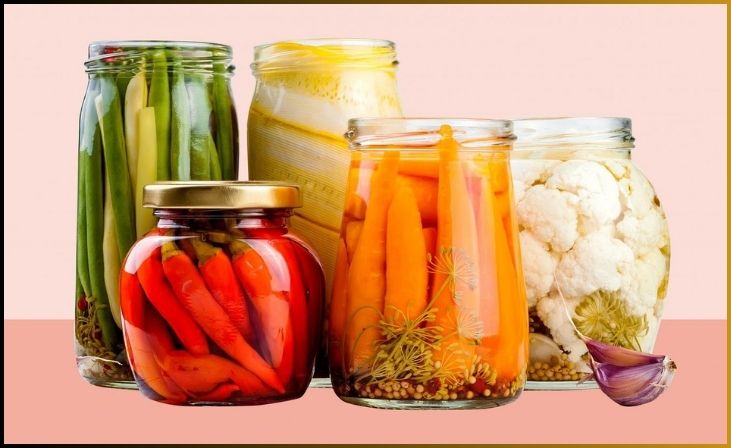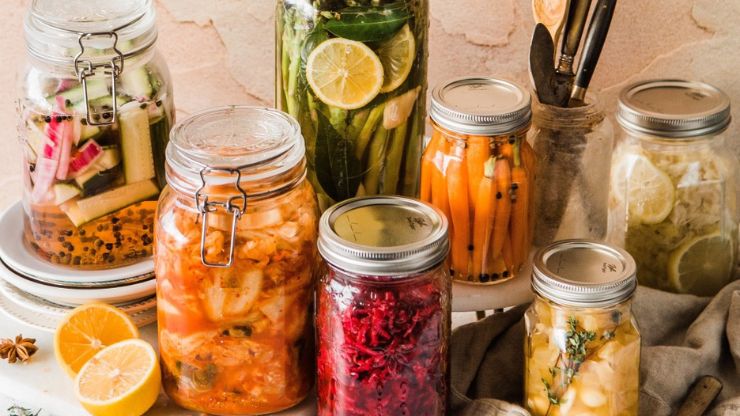My first few attempts at making sauerkraut resulted in a pink, moldy mess. I’ve come a long way since then, creating some delicious fermented foods for my family. If you want to try fermenting your own vegetables but the idea of poisoning your family intimidates you, read these tips for preventing mold in fermented food. This post will get you one step closer to your fermentation journey.
Fermentation is a fantastic tool for preserving food while adding health benefits at the same time. The process is very simple, and once you try it, you will find it’s quite addicting. Using tools like the airlock lids and weights that come with fermentors can make it even less intimidating to get started.
Although fermenting is simple, there are times when the dreaded mold happens. Mold can appear on the surface of your ferment for a variety of reasons. The tips I’ve gathered here will help ensure that the mold stays away. In my own experience, any time I get mold (which is actually pretty rare, so don’t be scared!), it’s because I didn’t follow one or more of these tips.
Table of Contents
ToggleTips to Prevent Mold in Fermented Food
• Always use clean equipment. It’s not necessary to sterilize your jars, weights, or lids, but they must be clean. Wash with soap and water and rinse thoroughly.
• Make sure your hands and tools are clean, too. Wash hands, knives, cutting boards, and any other items you will be using.
• Use the proper brine. While some experienced fermenters experiment without salt, I personally would not even attempt it. Whenever I ferment veggies, I prepare a brine; typically using 1 to 2 tablespoons of unrefined sea salt per quart of water.
• Use the right airspace. When the brine and weight have been added and you are ready to put a lid on your ferment, there should be about an inch of space between the surface of the brine and the rim of the jar. If the brine rises as the veggies ferment and release liquid, you can spoon some out, or if the brine level lowers you can add a bit more to the top. Just try to maintain that inch of space; any more and bad bacteria have more room to invade.
• If using spices and herbs in your ferment, the small pieces can be hard to keep under the brine/weight. You can put the small bits in a tea bag so it will stay beneath the weight.
Don't just scroll, subscribe!
BuzzTrail's unique web-stories are the cure for boredom you've been waiting for.
• Use the freshest vegetables you can find. The older the vegetables are, the more time bad bacteria have to grow on the surface.
• If tasting your veggies mid-ferment, make sure to use a clean fork, and don’t double-dip.
• Consider using tools. Airlocks are very helpful at keeping oxygen (which mold loves) out of your jar., and weights are crucial for keeping veggies under your brine.
Don’t let mold scare you away from the wonderful world of fermenting! With just a little bit of careful preparation, and by following these tips for preventing mold in your ferments, you’ll almost always have wild and tasty success.
How to Keep Fermented Food Mold-Free

To ensure a successful fermentation and prevent mold in your ferments, follow these steps:
- Start by thoroughly cleaning the vegetables and ensuring that your tools and work surfaces are also clean to prevent contamination. Avoid using any vegetables that show signs of mold or rot, and trim off any spoiled parts.
- When packing the vegetables into your fermenting vessel, pack them tightly to minimize the formation of air pockets.
- Submerge the vegetables completely under the brine, which can be a solution of salty water or water with whey, to create an anaerobic environment that promotes the growth of lactic acid bacteria.
- Place stone weights on top of the vegetables to keep them submerged under the brine. Ensure that there is a layer of brine above the weights to maintain the anaerobic conditions necessary for fermentation.
- Cover the crock’s trough with a lid and periodically add tap water as needed to prevent it from drying out. This water barrier prevents oxygen from entering the vessel but allows the release of fermentation gases.
By following these steps, you’ll increase the chances of a successful ferment while minimizing the risk of mold development.
Final Words
Successfully steering clear of mold during fermentation can significantly impact the quality of your ferments. By following the preventive tips outlined in this guide, you can significantly reduce the risk of mold and enjoy your homemade fermented creations with confidence. Remember, maintaining cleanliness, controlling environmental factors, and following best practices can ensure that your ferments turn out delicious, safe, and free from any unwelcome mold. With these strategies in place, you’re well-equipped to embark on your fermentation journey and savor the delightful results without worrying about mold issues.
FAQs
How can I tell if mold has developed in my ferment?
How can I tell if mold has developed in my ferment?
Mold in ferments often appears as fuzzy, discolored spots on the surface. If you see any signs of mold, it’s best to discard the entire batch.
What should I do if mold develops during fermentation?
What should I do if mold develops during fermentation?
If mold appears, remove it carefully along with the affected top layer. Then, check if the remaining content is still safe. If in doubt, it’s safer to discard the ferment.
Can I reuse equipment that had mold in a previous ferment?
Can I reuse equipment that had mold in a previous ferment?
It’s best to thoroughly clean and sterilize any equipment that had contact with mold. Even a small amount of residual mold can contaminate future batches.
Are there any specific fermented foods that are more prone to mold issues?
Are there any specific fermented foods that are more prone to mold issues?
Some ferments, like sauerkraut and kimchi, are more resilient against mold due to their low pH levels. However, any ferment can develop mold if proper precautions are not taken.

